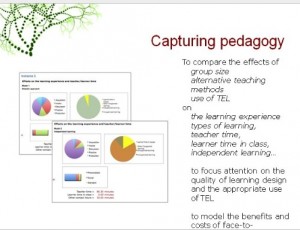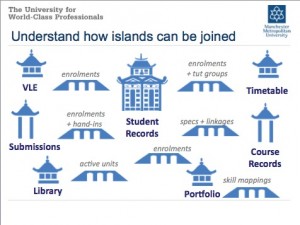We recently completed another round of PROD calls with the current JISC Curriculum Design projects. So, what developments are we seeing this time around?

Wordle of techs & standards used in Curriculum Design Prog, April 11
Well, in terms of baseline technologies, integrations and approaches the majority of projects haven’t made any major deviations from what they originally planned. The range of technologies in use has grown slighty, mainly due to in parts to the addition of software being used for video capture (see my previous post on the use of video for capturing evidence and reflection).
The bubblegram below gives a view of the number of projects using a particular standard and/or technology.
XCRI is our front runner, with all 12 projects looking at it to a greater or lesser extent. But, we are still some way off all 12 projects actually implementing the specification. From our discussions with the projects, there isn’t really a specific reason for them not implementing XCRI, it’s more that it isn’t a priority for them at the moment. Whilst for others (SRC, Predict, Co-educate) it is firmly embedded in their processes. Some projects would like the spec to be more extensive than it stands which we have know for a while and the XCRI team are making inroads into further development particularly with its inclusion into the European MLO (Metadata for Learning Opportunities) developments. As with many education specific standards/specifications, unless there is a very big carrot (or stick) widespread adoption and uptake is sporadic however logical the argument for using the spec/standard is. On the plus side, most are confident that they could implement the spec, and we know from the XCRI mini-projects that there are no major technical difficulties in implementation.
Modelling course approval processes has been central to the programme and unsurprisingly there has been much interest and use of formal modelling languages such as BPMN and Archimate. Indeed nearly all the projects commented on how useful having models, however complex, has been to engage stakeholders at all levels within institutions. The “myth busting” power of models i.e. this shows what actually what happens and it’s not necessarily how you believe things happen, was one anecdote that made me smile and I’m sure resonates in many institutions/projects. There is also a growing use of the Archi tool for modelling and growing sharing of experience between a number of projects and the EA (Enterprise Architecture) group. As Gill has written, there are a number of parallels between EA and Curriculum Design.
Unsurprisingly for projects of this length (4 years) and perhaps heightened by “the current climate”, a number of the projects have (or are still) in the process of fairly major institutional senior staff changes. This has had some impact relating to purchasing decisions re potential institution wide systems, which are generally out of the control of the projects. There is also the issue of loss of academic champions for projects. This is generally manifesting itself in the projects by working on other areas, and lots of juggling by project managers. In this respect the programme clusters have also been effective with representatives from projects presenting to senior management teams in other institutions. Some of the more agile development processes teams have been using has also helped to allow teams to be more flexible in their approaches to development work.
One very practical development which is starting to emerge from work on rationalizing course databases is the automatic creation of course instances in VLEs. A common issue in many institutions is that there are no version controls for course within VLEs and it’s very common for staff to just create a new instance of a course every year and not delete older instances which apart from anything else can add up to quite a bit of server space. Projects such as SRC are now at the stage where there new (and approved) course templates are populating the course database which then triggers an automatic creation of a course in the VLE. Predict, and UG-Flex have similar systems. The UG-Flex team have also done some additional integration with their admissions systems so that students can only register for courses which are actually running during their enrollment dates.
Sharepoint is continuing to show a presence. Again there are a number of different approaches to using it. For example in the T-Spark project, their major work flow developments will be facilitated through Sharepoint. They now have a part time Sharepoint developer in place who is working with the team and central IT support. You can find out more at their development blog. Sharepoint also plays a significant role in the PiP project, however the team are also looking at integrations with “bigger” systems such as Oracle, and are developing a number of UI interfaces and forms which integrate with Sharepoint (and potentially Oracle). As most institutions in the UK have some flavour of Sharepoint deployed, there is significant interest in approaches to utilising it most effectively. There are some justifiable concerns relating to its use for document and data management, the later being seen as not one of its strengths.
As ever it is difficult to give a concise and comprehensive view from such a complex set of projects, who are all taking a slightly different approach to their use of technology and the methods they use for system integration. However many projects have said that the umbrella of course design has allowed them to discuss, develop the use of institutional administration and teaching and learning systems far more effectively than they have been able to previously. A growing number of resources from the projects is available from The Design Studio and you can view all the information we have gathered from the projects from our PROD database.

